More Than Animal Hides
Pre-Colonial Woodland Indian Clothing Materials and Adornments
Leather
Many of us think about Native American clothing of the past being made of animal hides, and indeed much of the material used to make clothing was tanned (cured) leather. The process of making animal hides into wearable leather is called hide-tanning. Hide-tanning was an activity done expertly by the Native American people. Hide-tanning was more than just an activity, it was a scientific process. Think about it. Taking a biological material (animal skin) that will naturally rot and actually stopping the decaying process and turning the skin into a soft, durable clothing material (leather) with the capability to last for years was an incredible technology. In fact, it still is a fascinating process and technology. But enough about hide-tanning. The truth is that while much clothing was made from animal hides, still other clothing materials were utilized.
Textiles
Most would not guess that the Native American peoples of pre-colonial America made garments from a type of cloth they made. Of what material did they make these textiles? Believe it or not, the materials one can obtain fibers from still exist to this day in our Northeastern woodland environment. It grows all around us in the form of certain plants and trees. For example, fibers from under the bark of certain kinds of cedar trees are fibrous, and can be turned into strings, which can then be twinned (woven) together to make a 'cloth.' From the stems of plants like nettles, dogbane (Indian hemp), and milkweed come fibers too. These fibers are fine, and were twisted together to make strong strings. Again, these strings could be woven together to make 'cloth' materials or textiles that were then made into garments. These fibers were many times dyed colors, so that they may be woven into vivid patterns. Many Native American cultures in the Northeast made certain garments, accessories, and even storage bags from textiles made of natural woven fibers.
|
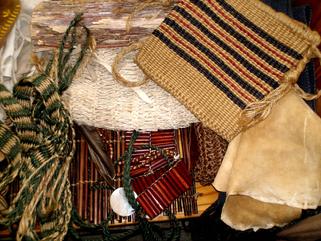 |
| Native American natural fiber clothing and accessories. |
|
|
Embellishments
More than just dying or painting clothing, materials were added to enhance garments. In certain areas of the Northeast, quills of the porcupine were flattened, dyed, and woven or sewn into patterns on clothing. We call this quillwork. In other areas of the Northeast, animal fur was dyed and then embroidered into designs on clothing. Moose hair embroidery was famously practiced in the Eastern Great Lakes. Even feathers have been sewn into pleasing designs and textures, such as turkey feather robes made by many in the Mid-Atlantic region. Other materials used to decorate clothing included items that may not have been local for many, such as mica from the Southeast, copper from Lake Superior, shells and even shark teeth from both the East coast and Gulf of Mexico. All these items had been traded to different areas of the Northeast - no matter their distance from the source.
|
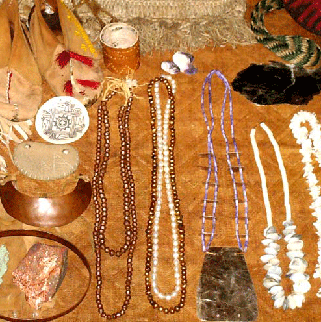 |
| Jewelry made of copper, fresh water pearls, mica, and shells. |
|
|
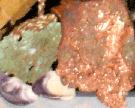 |
| Copper from the UP of Michigan. |
|
|
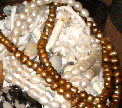 |
| Fresh water pearls and copper beads. |
|
|
Information for Students Using This Article as a Source for School Reports/Projects
Author: Jessica Diemer-Eaton
Year Posted: 2010
Company: Woodland Indian Educational Programs
Website: www.WoodlandIndianEDU.com
|
 |
| Scraping the fur off a deer hide. |
|
|
 |
| Olivia wears Mississippian style natural fiber clothes. |
|
|
Pigments
Both leather and textiles were dyed and painted pleasing colors and patterns. But where did the Native American people find their pigments used to make dyes? Many people believe they used berries, and for a couple kinds of berries, this did work. But most berries just did not produce bright color when they dried. Still, good dyes can come from plants, just think outside the berries. In fact, many dyes were made from the roots of plants, including a plant called Bloodroot. Bloodroot still grows in our forests today. And as the name might give away, the root of this plant contained a watery red colored juice. When cut into, the color is so rich it looks as though the root of this plant is bleeding. When it dries however, the pigment is more orange-red. If a person wanted a deeper red, they needed only to mix it with crushed red ocher, a type of mineral-rock. Minerals and clays were a great source of color. Other sources included walnuts. The walnut hull provided a deep, near black pigment. Pigments existed in many natural sources, all of which the Native American people exploited and processed expertly.
|
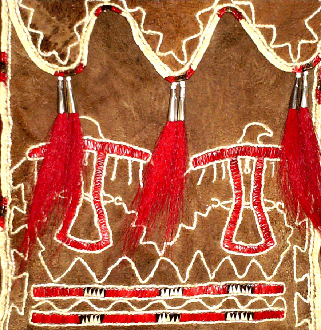 |
| Quillwork creates this Thunderbird design on a hunting bag. |
|
|
Copper
One large misconception about the Native American people of pre-colonial times is that they where not metal workers. This is actually not true. While not all communities in the Northeast had a use for metal, many societies did practice copper-working. Most of the copper used in pre-colonial America came from one source - large copper deposits around Lake Superior. This copper, thousands of pounds of it, was mined by the Native American people and traded far and wide hundreds of years before Columbus. Most copper was processed into jewelry, objects, and tools using a method called cold-hammer copper-working. This method required less heat. It should be noted, however, that there is evidence that some Native American people may have also used high-heat processing methods to form copper items in molds, such as celt (axe) heads.
|
 |
| Hopewell Copper Adornment, Field Museum in Chicago |
|
|
|